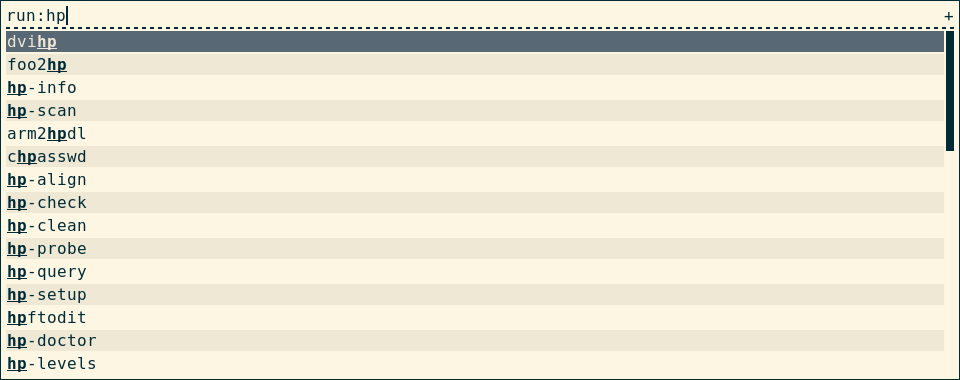Please match the documentation and scripts to the version of rofi used
Also see the locally installed documentation (manpages).
<h1 align="center"> Rofi </h1> <p align="center"><i>A window switcher, Application launcher and dmenu replacement</i>.</p>Rofi started as a clone of simpleswitcher, written by Sean Pringle - a popup window switcher roughly based on superswitcher. Simpleswitcher laid the foundations, and therefore Sean Pringle deserves most of the credit for this tool. Rofi (renamed, as it lost the simple property) has been extended with extra features, like an application launcher and ssh-launcher, and can act as a drop-in dmenu replacement, making it a very versatile tool.
Rofi, like dmenu, will provide the user with a textual list of options where one or more can be selected. This can either be running an application, selecting a window, or options provided by an external script.
What is rofi not?
Rofi is not:
-
A UI toolkit.
-
A library to be used in other applications.
-
An application that can support every possible use-case. It tries to be generic enough to be usable by everybody.
- Specific functionality can be added using scripts or plugins, many exists.
-
Just a dmenu replacement. The dmenu functionality is a nice 'extra' to rofi, not its main purpose.
Table of Contents
Features
Its main features are:
-
Fully configurable keyboard navigation
-
Type to filter
- Tokenized: type any word in any order to filter
- Case insensitive (togglable)
- Support for fuzzy-, regex-, prefix-, and glob-matching
-
UTF-8 enabled
- UTF-8-aware string collating
- International keyboard support (`e -> è)
-
RTL language support
-
Cairo drawing and Pango font rendering
-
Built-in modes:
-
Window switcher mode
- EWMH compatible WM
- Work arounds for i3,bspwm
-
Application launcher
-
Desktop file application launcher
-
SSH launcher mode
-
File browser
-
Combi mode, allowing several modes to be merged into one list
-
-
History-based ordering — last 25 choices are ordered on top based on use (optional)
-
Levenshtein distance or fzf like sorting of matches (optional)
-
Drop-in dmenu replacement
- Many added improvements
-
Easily extensible using scripts and plugins
-
Advanced Theming
Modes
Rofi has several built-in modes implementing common use cases and can be extended by scripts (either called from Rofi or calling Rofi) or plugins.
Below is a list of the different modes:
-
run: launch applications from $PATH, with option to launch in terminal.
-
drun: launch applications based on desktop files. It tries to be compliant to the XDG standard.
-
window: Switch between windows on an EWMH compatible window manager.
-
ssh: Connect to a remote host via ssh.
-
filebrowser: A basic file-browser for opening files.
-
keys: list internal keybindings.
-
script: Write (limited) custom mode using simple scripts.
-
combi: Combine multiple modes into one.
Rofi is known to work on Linux and BSD.
Manpage
For more up to date information, please see the manpages. The other sections and links might have outdated information as they have relatively less maintainance than the manpages. So, if you come across any issues please consult manpages, discussion and issue tracker before filing new issue.
- Manpages:
Installation
Please see the installation guide for instructions on how to install Rofi.
Quickstart
Usage
This section just gives a brief overview of the various options. To get the full set of options see the manpages section above
Running rofi
To launch rofi directly in a certain mode, specify a mode with rofi -show <mode>.
To show the run dialog:
rofi -show run
Or get the options from a script:
~/my_script.sh | rofi -dmenu
Specify an ordered, comma-separated list of modes to enable. Enabled modes can
be changed at runtime. Default key is Ctrl+Tab. If no modes are specified,
all configured modes will be enabled. To only show the run and ssh
launcher:
rofi -modes "run,ssh" -show run
The modes to combine in combi mode.
For syntax to -combi-modes , see -modes.
To get one merge view, of window,run, and ssh:
rofi -show combi -combi-modes "window,run,ssh" -modes combi
Configuration
Generate a default configuration file
mkdir -p ~/.config/rofi rofi -dump-config > ~/.config/rofi/config.rasi
This creates a file called config.rasi in the ~/.config/rofi/ folder. You
can modify this file to set configuration settings and modify themes.
config.rasi is the file rofi looks to by default.
Please see the configuration guide for a summary of configuration options. More detailed options are provided in the manpages.
Themes
Please see the themes manpages for a detailed description.
The latest bundled themes can be found here.
Screenshots
Rezlooks:
![]()
Arthur:
![]()
Default theme:

Wiki
| ❗ **The Wiki is currently unmaintained and might contain outdated data ** |
|---|
Contents
- User scripts
- Examples
- dmenu Specs
- mode Specs
- F.A.Q..
- Script mode
- Creating an issue
- Creating a Pull request
Discussion places
The GitHub Discussions is the preferred location for discussions.
- GitHub Discussions
- IRC (#rofi on irc.libera.chat)
Stargazers over time
编辑推荐精选


Refly.AI
最适合小白的AI自动化工作流平台
无需编码,轻松生成可复用、可变现的AI自动化工作流


酷表ChatExcel
大模型驱动的Excel数据处理工具
基于大模型交互的表格处理系统,允许用户通过对话方式完成数据整理和可视化分析。系统采用机器学习算法解析用户指令,自动执行排序、公式计算和数据透视等操作,支持多种文件格式导入导出。数据处理响应速度保持在0.8秒以内,支持超过100万行数据的即时分析。


TRAE编程
AI辅助编程,代码自动修复
Trae是一种自适应的集成开发环境(IDE),通过自动化和多元协作改变开发流程。利用Trae,团队能够更快速、精确地编写和部署代码,从而提高编程效率和项目交付速度。Trae具备上下文感知和代码自动完成功能,是提升开发效率的理想工具。


AIWritePaper论文写作
AI论文写作指导平台
AIWritePaper论文写作是一站式AI论文写作辅助工具,简化了选题、文献检索至论文撰写的整个过程。通过简单设定,平台可快速生成高质量论文大纲和全文,配合图表、参考文献等一应俱全,同时提供开题报告和答辩PPT等增值服务,保障数据安全,有效提升写作效率和论文质量。


博思AIPPT
AI一键生成PPT,就用博思AIPPT!
博思AIPPT,新一代的AI生成PPT平台,支持智能生成PPT、AI美化PPT、文本&链接生成PPT、导入Word/PDF/Markdown文档生成PPT等,内置海量精美PPT模板,涵盖商务、教育、科技等不同风格,同时针对每个页面提供多种版式,一键自适应切换,完美适配各种办公场景。


潮际好麦
AI赋能电商视觉革命,一站式智能商拍平台
潮际好麦深耕服装行业,是国内AI试衣效果最好的软件。使用先进AIGC能力为电商卖家批量提供优质的、低成本的商拍图。合作品牌有Shein、Lazada、安踏、百丽等65个国内外头部品牌,以及国内10万+淘宝、天猫、京东等主流平台的品牌商家,为卖家节省将近85%的出图成本,提升约3倍出图效率,让品牌能够快速上架。


iTerms
企业专属的AI法律顾问
iTerms是法大大集团旗下法律子品牌,基于最先进的大语言模型(LLM)、专业的法律知识库和强大的智能体架构,帮助企业扫清合规障碍,筑牢风控防线,成为您企业专属的AI法律顾问。


SimilarWeb流量提升
稳定高效的流量提升解决方案,助力品牌曝光
稳定高效的流量提升解决方案,助力品牌曝光


Sora2视频免费生成
最新版Sora2模型免费使用,一键生成无水印视频
最新版Sora2模型免费使用,一键生成无水印视频


Transly
实时语音翻译/同声传译工具
Transly是一个多场景的AI大语言模型驱动的同声传译、专业翻译助手,它拥有超精准的音频识别翻译能力,几乎零延迟的使用体验和支持多国语言可以让你带它走遍全球,无论你是留学生、商务人士、韩剧美剧爱好者,还是出国游玩、多国会议、跨国追星等等,都可以满足你所有需要同传的场景需求,线上线下通用,扫除语言障碍,让全世界的语言交流不再有国界。
推荐工具精选
AI云服务特惠
懂AI专属折扣关注微信公众号
最新AI工具、AI资讯
独家AI资源、AI项目落地

微信扫一扫关注公众号






